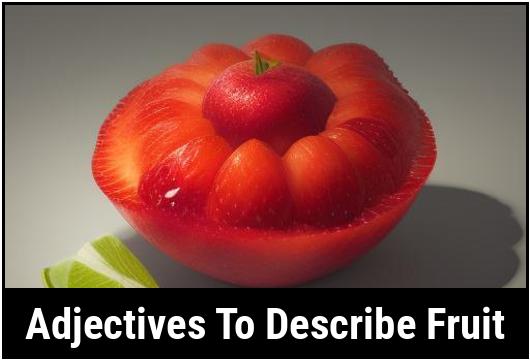- You are here:
- Home »
- adjectives
- » 31 Adjectives To Describe Fruit

31 Adjectives To Describe Fruit
Fruits come in a myriad of colors, shapes, sizes, textures, and flavors. They have the power to tantalize our taste buds and ignite our senses. When trying to put their delightful characteristics into words, adjectives play a crucial role in capturing the essence of these delectable treats. Descriptive adjectives help paint a vivid picture, allowing us to convey the unique attributes of fruits in a more compelling and expressive manner.
Key Takeaways
- Adjectives are essential in articulating the diverse qualities of fruits, enhancing the sensory experience of describing them.
- Using appropriate adjectives can help evoke emotions and create detailed imagery in writing about fruits.
- Adjectives play a key role in marketing, as they can influence consumer perception and preference for various fruits.
Adjectives To Describe Fruit
1. Juicy
Many fruits are bursting with juicy goodness, offering a delightful burst of refreshment with every bite. From watermelon to oranges, the sensation of crisp and succulent juiciness can be invigorating and thirst-quenching.
2. Sweet
Nature’s candy, fruits often possess a naturally sweet taste. The sweetness varies among fruits, ranging from the delicate sweetness of grapes to the intense sweetness of pineapples. This inherent sweetness makes fruits a delicious and healthy alternative to processed sugary snacks.
3. Tart
Some fruits, such as lemons and green apples, are known for their tartness. This sharp, tangy flavor adds a zesty and refreshing element to dishes. The tartness of these fruits can wake up the taste buds and offer a perfect balance to other flavors.
4. Refreshing
With their high water content, many fruits have a naturally refreshing quality. Enjoying a slice of watermelon or cucumber can provide a cooling sensation that is especially invigorating on a hot summer day. The crispness and juiciness of fruits contribute to their overall refreshing nature.
5. Exotic
Many tropical fruits, like dragon fruit, papaya, and passion fruit, emit an air of exoticism. Their unique appearance, vibrant colors, and unusual flavors make them intriguing and sought-after treats. Exploring different exotic fruits can be an exciting adventure for adventurous taste buds.
6. Fragrant
Fruits often emit a delightful aroma that can awaken the senses and increase anticipation. Picking up the scent of a ripe peach or a freshly sliced mango can transport you to a tropical paradise. The aroma of certain fruits is irresistible and can sometimes be as enticing as the taste itself.
7. Nutritious
Fruits are incredibly nutritious, packed with essential vitamins, minerals, and fiber that promote overall health and well-being. They provide vital nutrients like vitamin C, potassium, and antioxidants and are a natural way to boost your immune system and ensure you get the nutrients your body needs.
8. Wholesome
Adding fruits to your diet contributes to an overall sense of well-being and wholesomeness. Their natural goodness and vibrant colors bring a sense of vitality to any meal or snack. Enjoying fruits not only satisfies your taste buds but also nourishes your body and soul.
9. Aromatic
Beyond their taste, fruits often possess distinct aromatic qualities. The rich scent of ripe berries or the floral notes of a perfectly ripe peach can enhance the culinary experience. Incorporating aromatic fruits into desserts or adding them to salads can elevate the flavors in extraordinary ways.
10. Colorful
One cannot ignore the vibrant colors fruits bring to the culinary palette. From glossy red apples to sunny yellow bananas or deep purple grapes, fruits come in an array of colors that make them visually appealing. Their shades can brighten any dish and make it aesthetically pleasing.
11. Versatile
Fruits lend themselves well to a myriad of preparations and dishes. They can be enjoyed raw, juiced, blended into smoothies, baked, grilled, or dried. Their versatility makes them suitable for breakfast, lunch, dinner, and snacks, allowing for endless possibilities in the kitchen.
12. Crisp
Many fruits, such as apples and pears, have a crisp texture that offers a satisfying crunch. Biting into a crisp fruit can be an enjoyable sensation, adding a unique textural element to any dish or snack. The crispness of fruits can also indicate freshness and quality.
13. Satisfying
Fruits are often satisfying due to their natural sugars, fiber, and water content. They can satiate hunger pangs, providing a feeling of fullness without being heavy or laden with unnecessary calories. Adding a serving of fruit to your meals can contribute to a balanced and satisfying diet.
14. Delicate
Certain fruits have a delicate nature, both in flavor and texture. Think of the delicate sweetness and soft texture of a ripe pear, or the fragility of raspberries. These fruits require careful handling and deserve to be savored gently to fully appreciate their delicate qualities.
15. Zesty
Citrus fruits, such as lemons and oranges, possess a unique zestiness that adds vibrancy to recipes. The tangy and slightly bitter notes of these fruits can awaken the taste buds and add depth to marinades, dressings, and even desserts. The zestiness of these fruits brings a burst of flavor to any dish.
16. Scented
Certain fruits, like strawberries and pineapples, have a natural and distinct scent that is instantly recognizable. Whether used for culinary purposes or as added fragrance to skincare products, their scents evoke freshness, evoke pleasant memories, and add a tropical touch to any environment.
17. Summery
A wide variety of fruits bloom during the summer season, often associated with sunshine and warmth. Fruits such as watermelon, berries, and stone fruits like peaches and plums are often enjoyed during this season. Their flavors and colors remind us of the joys of summer, picnics, and beach trips.
18. Earthy
While fruits are often associated with sweetness, some possess earthy tones that add depth to dishes. Figs and dates, for example, have a rich earthiness that pairs well with cheeses and charcuterie. The earthy flavors of certain fruits provide a delightful contrast and create a unique culinary experience.
19. Citrusy
Citrus fruits like oranges, lemons, and grapefruits have a distinct citrusy flavor that is undeniably refreshing. Their tangy and bright taste is often associated with energy and is perfect for waking up the taste buds in the morning or adding a zing to desserts and beverages.
20. Silky
Some fruits, such as bananas and avocados, have a silky smooth texture that glides effortlessly on the tongue. The creaminess of these fruits adds a luxurious element to desserts, spreads, and smoothies. A silky fruit can create a delightful contrast when paired with fruits with a crisper texture.
21. Exquisite
Certain fruits possess a unique combination of flavors, textures, and aesthetics, making them truly exquisite. Think of the delicate sweetness and intricate patterns of a star fruit or the intricate layers and tropical taste of a pineapple. These fruits are not only delicious but also visually stunning.
22. Whimsical
Fruits like kiwi, dragon fruit, and pomegranate are delightfully whimsical in their appearance. With their vibrant colors, unusual textures, and playful seeds, they add a touch of lightheartedness and curiosity to any dish. Incorporating these fruits can transform an ordinary meal into a whimsical culinary experience.
23. Nourishing
Fruits are a source of nourishment for our bodies, providing essential vitamins and minerals that support our well-being. Whether it’s the vitamin C in citrus fruits, the potassium in bananas, or the antioxidants in blueberries, fruits offer a natural way to nourish our bodies and promote good health.
24. Energizing
Fruits are a fantastic source of natural energy due to their natural sugars and essential nutrients. Consuming fruits provides a sustainable boost of energy that can help keep you alert and focused throughout the day. Skip the energy drinks and opt for a juicy piece of fruit to re-energize yourself.
25. Tasty
From the first tangy bite of a fresh apple to the burst of flavors in a tropical fruit salad, fruits are undoubtedly tasty. Their natural goodness and inherent sweetness make them a go-to choice for satisfying cravings and enjoying guilt-free indulgence. Fruits exemplify that healthy food can indeed be delicious.
26. Satiating
The fiber content in many fruits contributes to their satiating nature. They can help you feel full and satisfied, making them an excellent choice for a midday snack or as part of a balanced meal. The satiating effect of fruits can prevent overeating and aid in maintaining a healthy body weight.
27. Succulent
The term succulent accurately describes fruits like peaches, plums, and cherries, which brim with juicy flavors. Biting into a succulent fruit presents a burst of rich and satisfying flavors that can truly delight the taste buds. Their juicy nature reminds us of the natural abundance provided by the plant world.
28. Quenching
When thirst strikes, few things are as satisfying as biting into a juicy piece of fruit. Many fruits, such as watermelon, pineapples, and grapes, have a high water content that quenches thirst effectively. Fruits offer a delicious and hydrating solution to beat dehydration and keep your body replenished.
29. Invigorating
The natural sugars and vibrant flavors of fruits can be invigorating to the senses. Fruits like citrus fruits and berries bring a burst of freshness that awakens the taste buds and rejuvenates the mind. The invigorating qualities of fruits can provide an instant mood lift and a boost of vitality.
30. Abundant
Fruits are abundant gifts from nature, showcasing the diversity and abundance of our planet’s offerings. From tropical fruits in lush rainforests to orchards bursting with apples or grapevines heavy with clusters of grapes, fruits symbolize the generosity of nature and remind us to appreciate its bountiful gifts.
31. Joyful
The colorful, juicy, and flavorful nature of fruits can bring a sense of joy and happiness to any occasion. Whether it’s a bowl of freshly cut fruit or as a topping for a celebratory cake, their presence adds a cheerful and lighthearted touch. The joyfulness of fruits is infectious and can brighten anyone’s day.
Why Use Adjectives To Describe Fruit
Adjectives are fundamental tools for expressing the characteristics and attributes of fruits in a nuanced and detailed manner. When we look at fruits, we observe their color, texture, aroma, taste, and overall appearance. Using adjectives enables us to convey our sensory experiences and perceptions to others. Whether we are describing fruits for culinary purposes, marketing, or simply to evoke the sensations associated with them, adjectives enrich our descriptions and make them more engaging and vivid.
Furthermore, adjectives also enable us to differentiate between various types of fruits, whether it’s their sweetness, tartness, juiciness, or even their aesthetic appeal. By carefully choosing the right adjectives, we can effectively communicate the distinct qualities of each fruit, making it easier for others to understand and visualize their unique attributes.
How To Choose The Right Adjective To Describe Fruit
Selecting the suitable adjectives to describe fruits involves considering a range of factors, from their taste profile to their appearance and even cultural or historical significance. Here are some considerations to keep in mind when choosing adjectives:
Taste And Texture
When describing the taste and texture of fruits, it’s important to consider adjectives that capture their flavor, sweetness, tartness, juiciness, crunchiness, or creaminess. For instance, fruits can be described as luscious, succulent, juicy, crisp, tender, or creamy, depending on their specific qualities.
Aroma
The aroma of fruits plays a crucial role in their overall appeal. Adjectives such as fragrant, aromatic, sweet-scented, or zesty can be used to portray the delightful smells associated with different fruits.
Appearance
The visual allure of fruits can be effectively conveyed through adjectives that describe their color, shape, and overall appearance. Words like vibrant, luscious, radiant, plump, and exquisite can be used to paint a vivid picture of the visual appeal of fruits.
Rarity And Origin
Some fruits are rare or have unique origins, adding to their allure. Adjectives such as exotic, rare, indigenous, or tropical can be used to highlight the distinctiveness of such fruits, evoking a sense of adventure and discovery.
Types Of Adjectives For Describing Fruit
When it comes to describing fruits, a plethora of adjectives can be used to capture their diverse qualities and characteristics. Let’s explore some categories of adjectives commonly employed to depict fruits:
Taste And Flavor Adjectives
- Sweet: Describes fruits with a sugary taste, such as ripe mangoes or strawberries.
- Tangy: Conveys a sharp, acidic flavor, as found in citrus fruits like lemons and oranges.
- Tart: Refers to a sharp, sour taste, characteristic of certain berries and green apples.
- Refreshing: Denotes a revitalizing, invigorating taste, often associated with fruits like watermelon or cucumbers.
Texture Adjectives
- Juicy: Describes fruits that are moist and succulent, such as peaches, plums, and grapes.
- Crisp: Portrays a fruit that is firm and has a satisfying crunch, like apples or pears.
- Velvety: Conveys a smooth, soft texture, as observed in fruits like kiwi and ripe figs.
Aroma Adjectives
- Fragrant: Indicates a sweet, pleasant smell often found in fruits like melons and tropical fruits.
- Aromatic: Suggests a strong, distinctive scent, as seen in herbs such as basil and mint.
- Zesty: Refers to a lively, invigorating aroma, characteristic of citrus fruits like lime and grapefruit.
Appearance Adjectives
- Radiant: Describes fruits with a vibrant, glowing appearance, as seen in ripe, red strawberries or golden mangoes.
- Plump: Denotes fruits that are pleasantly rounded and full, like cherries or blueberries.
- Exquisite: Portrays fruits with an exceptional, aesthetically pleasing appearance, such as pomegranates or dragon fruits.
Origin And Rarity Adjectives
- Exotic: Conveys the unique, foreign nature of fruits such as passion fruit, dragon fruit, or lychee.
- Indigenous: Refers to fruits that are native to a specific region, highlighting their cultural significance and authenticity.
- Rare: Signifies fruits that are uncommon or scarce, enhancing their desirability and exclusivity.
Using adjectives to describe fruits allows us to convey their sensory attributes, visual appeal, and cultural significance in a more vivid and engaging manner. By carefully selecting adjectives that capture the taste, texture, aroma, appearance, and origin of fruits, we can enrich our descriptions and provide readers with a more immersive and evocative experience. Whether it’s for culinary writing, marketing, or simply sharing our love for fruits, adjectives play a crucial role in articulating the distinctive qualities of these delectable natural wonders.
Examples Of Adjectives For Different Types Of Fruit
When it comes to describing fruit, adjectives play an essential role in conveying their appearance, taste, texture, and overall qualities. These descriptive words not only bring the fruit to life but also help us set expectations and entice our senses. The right adjectives can create an appealing image of the fruit in the reader’s mind, making it more enticing and desirable.
-
Apples:
- Crisp: Apples that have a satisfyingly crunchy texture when bitten into.
- Juicy: Apples that are full of succulent, flavorful juice.
- Tart: Apples with a slightly sour or acidic taste profile.
- Sweet: Apples that have a pleasant, sugary taste.
- Refreshing: Apples that provide a revitalizing and cooling sensation.
-
Oranges:
- Citrusy: Oranges that have a distinct, tangy taste reminiscent of citrus.
- Zesty: Oranges with an invigorating, lively flavor.
- Juicy: Oranges that are bursting with refreshing juice.
- Sweet: Oranges with a delightful, sugary taste.
- Bright: Oranges that radiate a vibrant and vivid color.
-
Bananas:
- Creamy: Bananas that have a smooth and rich texture.
- Ripe: Bananas that are fully matured and have a stronger flavor.
- Mellow: Bananas that have a gentle, mild taste.
- Soft: Bananas that are tender and easy to bite into.
- Versatile: Bananas that can be used in various culinary creations.
-
Berries (Strawberries, Blueberries, Raspberries):
- Succulent: Berries that are juicy and mouthwatering.
- Tart: Berries that have a tangy, slightly acidic flavor.
- Plump: Berries that are pleasantly plump and full.
- Sweet: Berries that have a naturally sweet taste.
- Bursting: Berries that release their flavors explosively when bitten into.
-
Pineapple:
- Tropical: Pineapples that evoke images of exotic beaches and warm climates.
- Juicy: Pineapples that are filled with delicious, refreshing juice.
- Tangy: Pineapples with a zingy and slightly acidic taste.
- Fragrant: Pineapples that emit a delightful aroma.
- Sweet-and-sour: Pineapples with a unique combination of sweetness and tartness.
-
Watermelon:
- Juicy: Watermelons that are excessively filled with thirst-quenching juice.
- Refreshing: Watermelons that provide a revitalizing and cooling effect.
- Sweet: Watermelons that have a delectably sweet taste.
- Crisp: Watermelons that have a satisfying crunch when bitten into.
- Gargantuan: Watermelons that are enormous in size.
Common Mistakes In Using Adjectives To Describe Fruit
While describing fruit using adjectives may seem straightforward, there are some common mistakes that people make. These mistakes can result in confusing or inaccurate descriptions. Let’s take a look at these mistakes and how to avoid them:
- Overusing generic adjectives: Using generic adjectives that can apply to any fruit, such as "good" or "nice," can make your description lackluster and uninteresting. Instead, opt for more specific and vivid adjectives that capture the unique qualities of the fruit.
Incorrect: "The apple was good."
Correct: "The apple was crisp and juicy."
- Neglecting sensory details: When describing fruit, it’s essential to engage all the senses by including details about taste, texture, aroma, and appearance. Neglecting any of these sensory aspects can result in an incomplete description.
Incorrect: "The apple tasted sweet."
Correct: "The apple had a sweet and tangy flavor, with a crisp texture and a refreshing aroma."
- Using adjectives that contradict each other: Avoid using adjectives that contradict each other or create confusion about the fruit’s qualities. Be mindful of the coherence and consistency of your descriptions.
Incorrect: "The orange was both sour and sweet."
Correct: "The orange had a harmonious blend of tangy and sweet flavors."
- Failing to vary adjectives: Using the same adjectives repeatedly can make your description repetitive and monotonous. Try to explore a variety of adjectives that capture different aspects of the fruit.
Incorrect: "The banana was soft and sweet."
Correct: "The banana was soft, creamy, and delicately sweet."
- Neglecting the context: Consider the context in which the fruit is being described. Take into account factors such as ripeness, preparation, or pairing with other ingredients when selecting appropriate adjectives.
Incorrect: "The unripe banana was sweet."
Correct: "The ripe banana was sweet and fragrant."
Using Adjectives Effectively
To use adjectives effectively when describing fruit, consider the following tips:
-
Be specific: Instead of using generic adjectives, be specific and precise in your descriptions. Use vivid and detailed words that paint a clear picture of the fruit’s qualities.
-
Engage the senses: Make your description more immersive by including sensory details. Describe the taste, texture, aroma, and appearance of the fruit to fully capture its essence.
-
Use comparison and contrast: Comparing the fruit to something or contrasting its qualities against each other can provide a more nuanced and evocative description.
-
Consider the target audience: Adapt your language and choice of adjectives based on the target audience. Use more sophisticated vocabulary for a mature audience or simpler language for younger readers.
-
Experiment with figurative language: Explore the use of figurative language such as similes and metaphors to add depth and creativity to your descriptions. For example, "the berries were like a burst of flavor in my mouth" or "the apple’s skin was as smooth as silk."
-
Balance positive and negative adjectives: When describing fruit, it’s important to provide balanced feedback. Include both positive and negative adjectives when appropriate to give a comprehensive and honest description.
-
Edit and revise: After writing your description, take the time to revise and edit your adjectives. Ensure they accurately convey your intended meaning and create a vivid image of the fruit.
Exercises And Practice
To further enhance your understanding of using adjectives to describe fruit, here are a few exercises for practice:
Exercise 1: Choose five different fruits and write a descriptive paragraph for each fruit using at least three adjectives that highlight different qualities.
Exercise 2: Create a list of at least ten adjectives that can be used to describe the appearance, taste, texture, or aroma of fruit. Include both positive and negative adjectives.
Exercise 3: Take a picture of a piece of fruit and describe it using a combination of sensory details (e.g., taste, texture, appearance, aroma). Use a variety of adjectives to make the description as vivid as possible.
Exercise 4: Write a short story or a poem that revolves around a specific fruit. Use adjectives to bring the fruit to life and create an engaging narrative or poetic piece.
Conclusion
In conclusion, using adjectives to describe fruit is an art that can greatly enhance our understanding and appreciation of these delicious natural wonders. By selecting the right adjectives and incorporating sensory details, we can create vivid and captivating descriptions that entice our senses. Remember to be specific, engage the senses, and consider the context when choosing adjectives. Avoid common mistakes such as using generic adjectives, neglecting sensory details, or using contradictory words. With practice and creativity, you can master the skill of describing fruit using a diverse range of adjectives. So go ahead, take a bite of your favorite fruit, and let your words paint a delicious picture for others to savor.
FAQS On Adjectives To Describe Fruit
What Are Some Popular Adjectives Used To Describe Fruit?
Some popular adjectives to describe fruit include juicy, ripe, delicious, sweet, and fresh.
What Does It Mean For A Fruit To Be Juicy?
Juicy fruits have a high water content and are full of moisture, often bursting with flavor when eaten.
How Would You Describe A Ripe Fruit?
A ripe fruit is fully developed and ready to be eaten, usually characterized by its vibrant color, soft texture, and sweet taste.
Can You Give Examples Of Adjectives To Describe The Taste Of Fruit?
Some adjectives that can be used to describe the taste of fruit are tangy, tangy, bitter, and tart.
How Do You Describe A Fresh Fruit?
A fresh fruit typically refers to a fruit that is recently picked or bought and has not been processed or stored for a long time. This can be described with adjectives like crisp, vibrant, and flavorful.








